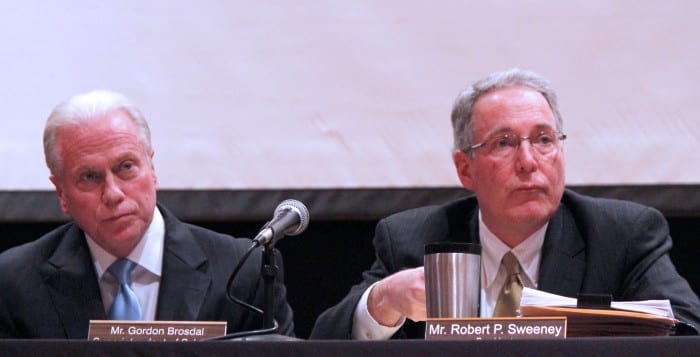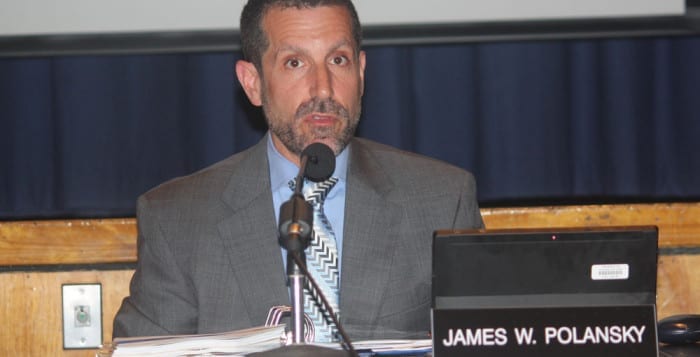Three Village and other districts recently received the results of an audit conducted by New York State Comptroller Thomas DiNapoli of the 2014-15 finances relating to the district’s fuel inventory management.
The comprehensive, six-month review of the district’s 2014-15 finances found that the fuel inventory was “overstated by 452 gallons of gasoline and 297 gallons of diesel fuel, with a total value of $1,725.”
That was a finding after a review of documents related to the district’s financial policies and procedures, including cash disbursements, payroll, fund balance and reserve management, cash flow to vendors, budget revenues and expenditures, among others.
Three Village board’s Audit Committee Chair Jonathan Kornreich said the state audit’s report accounts for nine-millionth of the district’s $188 million budget and amounts to about 2 gallons of gas per week.
Assistant Superintendent for Business Services Jeff Carlson, who said he was “pretty happy” with the audit, added that the district has already addressed the comptroller’s recommendations.
The comptroller recommends that the board write procedures for reconciliation of fuel, that the inventory be reconciled more frequently and that odometer readings on trucks be entered before fuel is dispensed. Additionally, the state suggests that Three Village “address any physical security concerns of the fueling station,” such as repositioning security cameras.
Changing Ward Melville?
In other news from Wednesday’s meeting, board trustee Jeff Kerman raised an uncomfortable issue involving a local legend. Kerman said he wants the board to consider having the district’s attorneys look into whether it is feasible to change the name of Ward Melville High school.
“I’m a little concerned about the name of our high school being named after an anti-Semite and named after a racist person,” Kerman told the board.
He said that Melville’s refusal to let Jews rent shops in the village or sell houses to blacks and Jews is not acceptable in today’s age.
This was the first time the topic has been broached. There were no public comments or discussion from the board.
Three Village superintendent collects major honor
Three Village teachers, administrators and staff gathered at the North Country Administration building last Wednesday to honor Superintendent Cheryl Pedisich.
Pedisich is the recipient of the first-ever Administrator of the Year award from the New York State School Counselor Association.
“We’ve realized how fortunate we are to have a truly outstanding educational leader,” School Board President Bill Connors said.
“It really is wonderful when an outside group comes and also affirms our own view of the superintendent and affirms the outstanding leadership that she’s provided.”
Pedisich, who had been nominated by Linda Bergson, coordinating guidance chairperson for the district, said she was honored to receive the award from an organization that represented her “origins as an educator.”
The superintendent’s 32-year career in Three Village began at Ward Melville High School as a guidance counselor. That is, in fact, how she and Bergson first met — Bergson’s son was one of the students Pedisich counseled.
Bergson read her nominating letter at Wednesday’s school board meeting. In it, she described Pedisich’s leadership as collaborative and respectful. The school superintendent is a wonderful listener, she said.
“And if she asks you to do something, she will always offer to help you accomplish it,” Bergson said.
Besides being detail-oriented and taking a “holistic” approach to problem-solving, “her work product is impeccable,” Bergson’s letter said.
Pedisich was selected from administrators statewide by a five-member committee, said NYSSCA President Barbara Donnellan, who attended the meeting with Executive Director Robert Rotunda to present the award to the Three Village superintendent.
She is a leader “who provides outstanding support to school counselors,” Donnellan said.
Pedisich’s counseling background is apparent in the way she works with students, parents, teachers and staff, Bergson said. She is able to find the right words to handle a situation and never makes anyone feel as though they’re taking up too much time, she added. Most impressive, though, is how Pedisich, who has been superintendent since 2012, acknowledges what people do and validates and praises their efforts, she said.
“It’s funny to watch her walk down the hall when she’s in the high school for a meeting, because she says hello to everyone by name — teachers, administrators, custodians, secretaries, security — she doesn’t just say hello, but she asks them questions that show that she knows them personally,” Bergson said.
Visibly touched, Pedisich thanked the “dedicated, skilled and talented” district staff, Three Village parents who are “invested in our children” and the school board, which she said “respects and values and demonstrates positive regard for all of its constituency.”
“I would not be in this position or the educator I am if it wasn’t for the people with whom I have worked,” she said.
“I am incredibly indebted to all of you… This will definitely be one of the most special and indelible moments of my career.”
This version corrects the number of years Cheryl Pedisich has worked in the Three Village school district.














